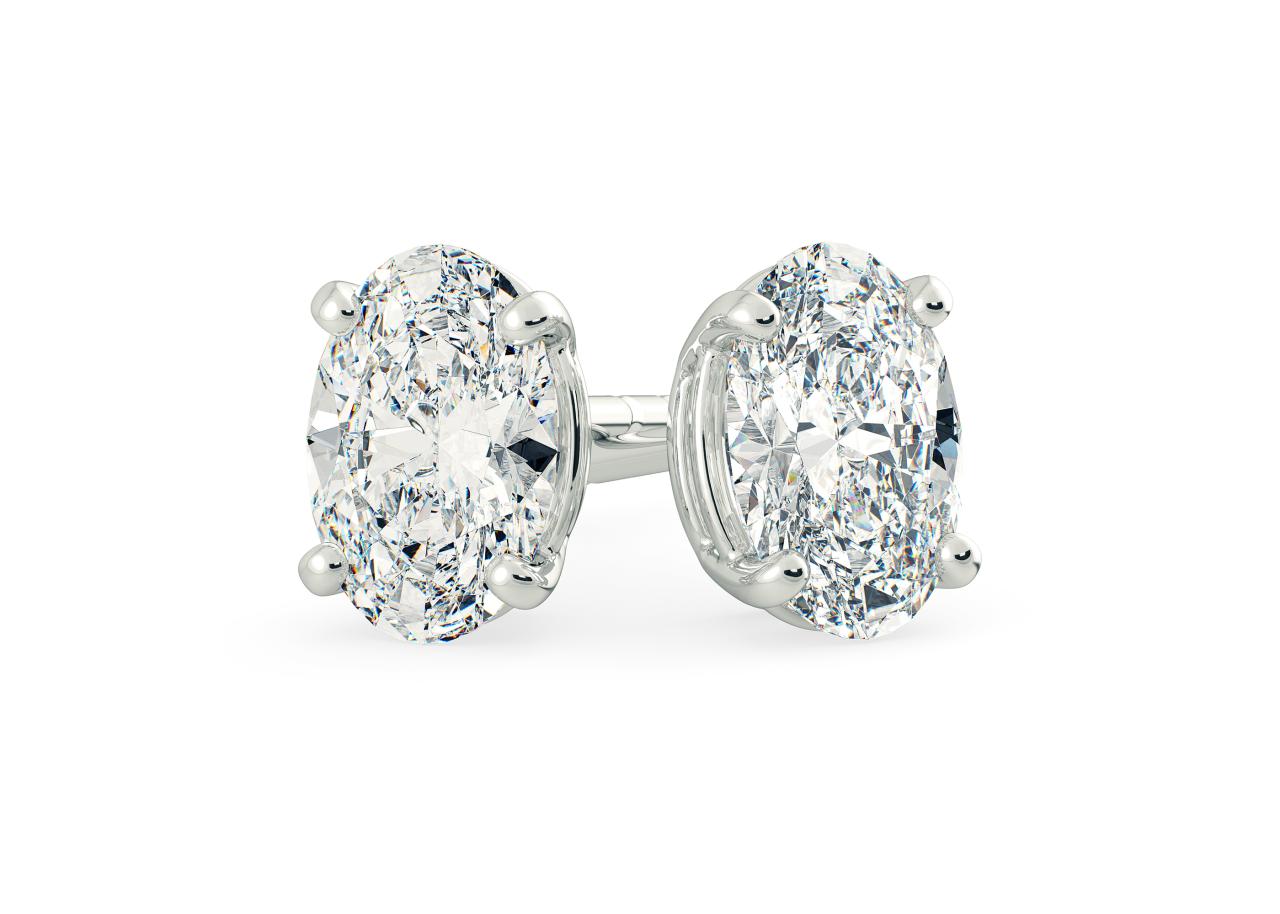The allure of a diamond has always captivated humanity, a symbol of enduring beauty, commitment, and luxury. For centuries, this fascination was tethered exclusively to the Earth’s depths, where these precious gems formed over eons. Today, however, a new era of brilliance has dawned: the lab-grown diamond. These aren’t imitations or simulants; they are diamonds, chemically, physically, and optically identical to their mined counterparts, born not from geological forces but from cutting-edge technology. And when we talk about making a statement, few pieces of jewelry rival the timeless elegance and undeniable impact of a pair of 2-carat diamond studs.
This article delves into the exciting world of 2-carat lab-grown diamond studs, exploring why they represent a paradigm shift in luxury, offering unparalleled value, ethical assurance, and sustainable elegance for the modern consumer.
Understanding Lab-Grown Diamonds: Science Meets Sparkle
Before we immerse ourselves in the splendor of 2-carat studs, it’s crucial to understand what a lab-grown diamond truly is. Unlike diamond simulants such as cubic zirconia or moissanite, which merely look like diamonds, lab-grown diamonds are diamonds. They possess the exact same atomic structure, chemical composition (pure carbon), and optical properties as diamonds extracted from the earth. The only difference lies in their origin.
There are two primary methods for creating lab-grown diamonds:
- High-Pressure/High-Temperature (HPHT): This method mimics the natural diamond-growing conditions deep within the Earth. A tiny diamond seed is placed in a growth chamber with carbon materials (like graphite) and subjected to immense pressure and high temperatures, allowing carbon atoms to crystallize around the seed.
- Chemical Vapor Deposition (CVD): In this process, a diamond seed is placed in a vacuum chamber, and carbon-rich gases are introduced. Microwaves break down the gas molecules, allowing carbon atoms to deposit layer by layer onto the seed, gradually forming a larger diamond crystal.
Both methods produce genuine diamonds, indistinguishable from mined diamonds without specialized equipment. This scientific marvel is what makes the prospect of owning significant carat weights, like 2-carat studs, so much more accessible and appealing.
The Undeniable Allure of 2-Carat Diamond Studs
A single 2-carat diamond is a substantial gem, and a pair of 2-carat studs means each ear will feature a diamond of that impressive size. This isn’t just about weight; it’s about visual impact. A 2-carat diamond measures approximately 8.1 mm in diameter (for a round brilliant cut), a noticeable and commanding presence on the ear.
Diamond studs, in general, are a cornerstone of any jewelry collection. They are the epitome of versatile elegance, transitioning seamlessly from casual daytime wear to sophisticated evening events. They add a touch of sparkle and polish without being overly ostentatious, yet a 2-carat size elevates them from subtle accent to a genuine statement piece. They frame the face beautifully, catching the light with every turn of the head, and project an air of confidence and refined taste.
For many, a 2-carat diamond was once an aspirational dream, often financially out of reach. Lab-grown technology has democratized this level of luxury, making it a tangible reality for a broader audience.
The Ethical and Sustainable Choice
Beyond the sheer beauty and impressive size, lab-grown 2-carat diamond studs carry significant ethical and environmental advantages that resonate deeply with today’s conscious consumer.
-
Guaranteed Conflict-Free: The term "blood diamond" cast a long shadow over the diamond industry, referring to diamonds mined in war zones and sold to finance armed conflicts. While initiatives like the Kimberley Process have made strides, verifying the origin of every mined diamond remains complex. Lab-grown diamonds, by their very nature, are guaranteed conflict-free. Their origin is transparent and traceable, offering complete peace of mind to the wearer.
-
Reduced Environmental Footprint: Diamond mining is an intensive process that can involve significant land disruption, habitat destruction, and substantial energy consumption. While lab-grown diamond production also requires energy, it is a more controlled and often more energy-efficient process. Advancements in technology are continuously improving the sustainability of labs, with many utilizing renewable energy sources. This results in a considerably smaller environmental footprint compared to traditional mining, making lab-grown diamonds a more eco-conscious choice.
-
Ethical Labor Practices: The conditions under which diamonds are mined and processed in certain regions have historically raised concerns about labor exploitation. Lab-grown diamonds are produced in controlled laboratory environments, adhering to stringent labor laws and ethical employment practices, ensuring fair wages and safe working conditions.
Choosing lab-grown 2-carat diamond studs is not just about acquiring a beautiful piece of jewelry; it’s about making a statement that aligns with personal values of social responsibility and environmental stewardship.
Unrivaled Value and Quality
Perhaps one of the most compelling arguments for lab-grown diamonds, particularly at significant carat weights like 2-carat, is the extraordinary value they offer without compromising on quality.
-
Exceptional Price Point: Due to their controlled production environment and shorter supply chain, lab-grown diamonds are typically 30-50% less expensive than their mined counterparts of comparable size and quality. This price differential is particularly pronounced at higher carat weights. This means that a 2-carat lab-grown diamond stud, which might have been a dream purchase, becomes a much more attainable reality, allowing consumers to acquire a larger, higher-quality diamond for their budget.
-
Identical Quality to Mined Diamonds: It cannot be stressed enough: lab-grown diamonds are real diamonds. They exhibit the same brilliance, fire, and scintillation. They are graded using the same universally accepted "4 Cs" (Carat, Cut, Color, Clarity) by independent gemological laboratories such as IGI (International Gemological Institute), GIA (Gemological Institute of America), and GCAL (Gem Certification & Assurance Lab). This means you can select a lab-grown diamond with confidence, knowing its quality is objectively assessed and certified.
This combination of superior value and identical quality makes lab-grown 2-carat diamond studs a truly smart luxury purchase. You get the same breathtaking sparkle and enduring beauty, but with a more favorable price tag and a clear conscience.
Navigating Your Purchase: The 4 Cs and Beyond
When selecting your 2-carat lab-grown diamond studs, understanding the 4 Cs is paramount to ensure you choose diamonds that truly sparkle. Remember, you’re buying a pair, so consistency between the two stones is important.
-
Carat: This is already determined at 2-carat (meaning each diamond is 2 carats, for a total of 4 carats total weight). This substantial size guarantees a striking presence.
-
Cut: The cut is arguably the most crucial C, as it dictates how well a diamond interacts with light. An excellent or ideal cut will maximize a diamond’s brilliance, fire, and scintillation. For studs, a well-cut diamond ensures they truly "pop" on the ear. Look for certifications that specify "Excellent" or "Ideal" cut grades.
-
Color: Diamond color is graded on a scale from D (colorless) to Z (light yellow or brown). For studs, aiming for the near-colorless range (G, H, I, J) offers excellent value and beauty. At 2 carats, a slightly lower color grade might be more noticeable, so many prefer to stay within the D-H range if budget allows.
-
Clarity: Clarity refers to the absence of inclusions (internal flaws) and blemishes (external flaws). The scale ranges from Flawless (FL) to Included (I). For studs, an "eye-clean" diamond is often the goal – meaning no inclusions are visible to the naked eye. This typically falls within the VS1 (Very Slightly Included 1) to SI1 (Slightly Included 1) range, offering a balance of beauty and value.
Beyond the 4 Cs, consider the certification. Always insist on a reputable third-party grading report from IGI, GIA, or GCAL. These reports provide an objective assessment of the diamond’s characteristics, ensuring transparency and authenticity.
Finally, think about the metal setting. Platinum and white gold are popular choices as they enhance the colorless appearance of diamonds. Yellow gold can create a beautiful contrast, especially with diamonds in the lower color grades, giving them a warmer glow. The most common setting for studs is a simple 4-prong or 6-prong basket setting, which allows maximum light entry and showcases the diamond itself.
The Future of Diamond Jewelry is Here
The rise of lab-grown diamonds, particularly in significant sizes like 2-carat studs, is not a fleeting trend but a fundamental shift in the jewelry industry. It empowers consumers with more choices, offering a blend of luxury, ethics, and value that was previously unattainable. As technology advances and consumer awareness grows, lab-grown diamonds are poised to become an even more dominant force in the market.
Choosing 2-carat lab-grown diamond studs is more than just purchasing a beautiful accessory; it’s an embrace of innovation, a commitment to ethical consumption, and an investment in a piece of jewelry that will bring joy and sparkle for a lifetime. These dazzling gems represent a conscious luxury, proving that true brilliance can indeed be cultivated.


